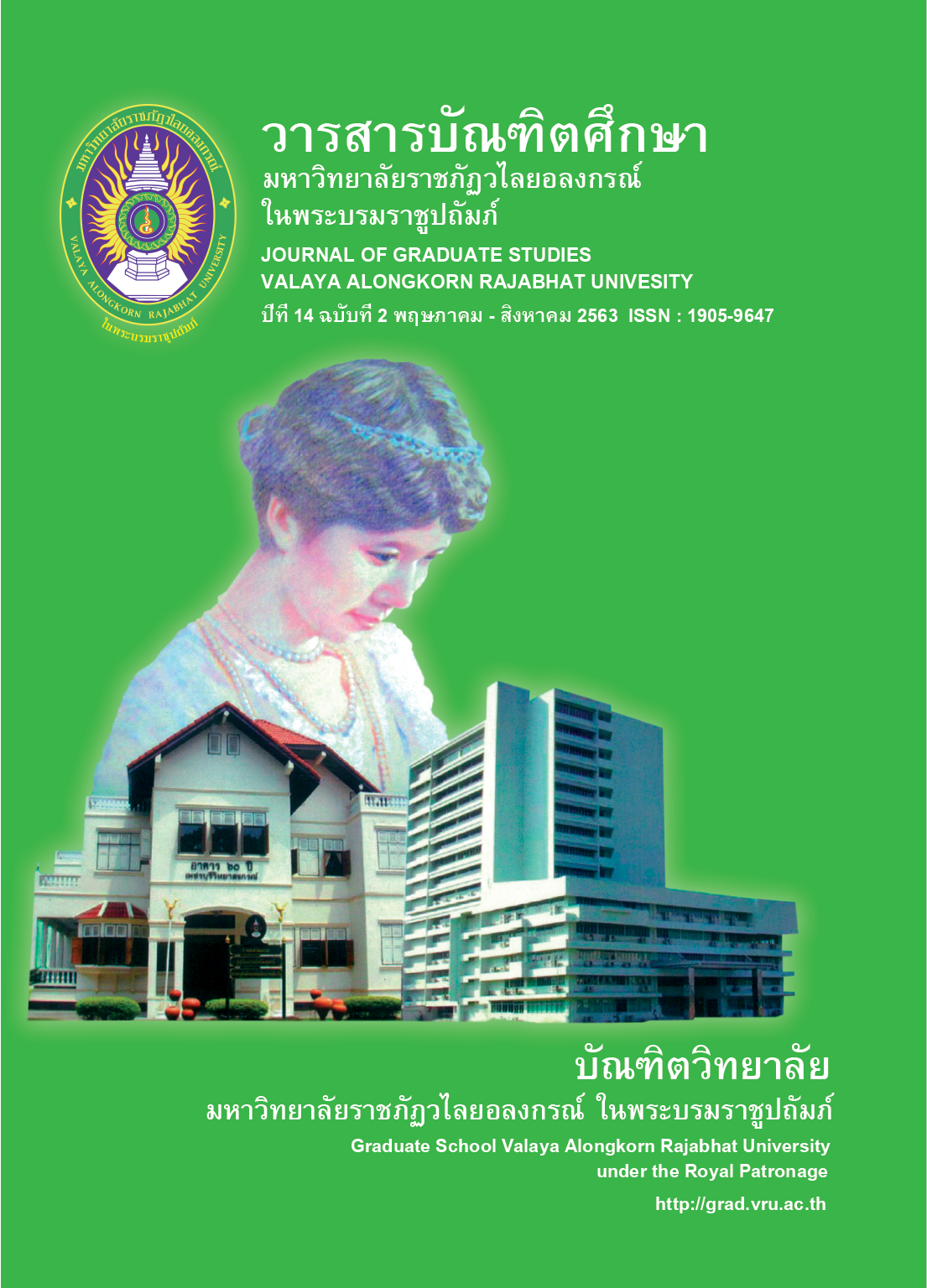GUIDELINE FOR COMMUNICATING RAMTONE NOKPHITHID TO CONSERVE AND PROMOTE COMMUNITY TOURISM
Main Article Content
Abstract
The objectives of this research were to study the history, beliefs and current situation of Ramtone Nokphithid and to find ways to communicate this folk play for conservation and promotion of tourism. The researchers used qualitative research method by using an interview form to interview key informants with snow ball sampling and do focus group of community leaders, tourism community enterprises and Ramtone Nokphithid local scholars. The result showed that Ramtone Nokphithid came from the central region during period of Field Marshal Plaek Phibunsongkhram during World War II. Ramtone Nokphithid was used the tool for entertainment among poor economics and also during the political conflict period. This folk play was disseminated from the city to Krung Ching Subdistrict. Then, local scholar invented songs and lyrics in hundreds of songs based on the nature and way of life of people there. The dance is consistent with the lyrics. The lyrics are short. The Nokphithid song (Nokphithid is similar to owl) has funny posture and lyric. It looks like the courtship between male and female Nokphithid. Therefore, it is performed in every event and is named "Ramtone Nokphithid". The music consists of 3 instruments; drum (Tone in Thai), small cup-shaped cymbals and cymbals. For the belief, the performers are very reliable for “Wai Khru” (paying respect to teacher) before every performance which is similar to the Manohra folk play and they believe in the inheritance of the folk play from the same family or relatives which is similar to the Manora folk play. For the current situation, there is only the elderly group, consequently, they need young people to continue this performance. The elders are willing to train the youths. In the past, there were training in the school both from teachers in the school and from the local scholars. However, when students moved to other schools for further study, they did not practice folk play continuously. However, Krung Ching Subdistrict Administrative Organization and the Culture department of Nopphitam District aware of this importance and try to promote in order to publicize this folk play to be known. For communication guideline of this folklore to conserve and promote community tourism, most important key informants agreed to use online communication as a video clip to publicize media, establish learning center and create pamphlet to do public relations. In addition, there should be also a stage or area of expression for youth to build confidence and pride in the conservation and continuation of their Ramtone Nokphithid folklore.
Article Details
บทความทุกเรื่องได้รับการตรวจความถูกต้องทางวิชาการโดยผู้ทรงคุณวุฒิ ทรรศนะและข้อคิดเห็นในบทความวารสารบัณฑิตศึกษา มหาวิทยาลัยราชภัฏวไลยอลงกรณ์ ในพระบรมราชูปถัมภ์ มิใช่เป็นทรรศนะและความคิดของผู้จัดทำจึงมิใช่ความรับผิดชอบของบัณฑิตวิทยาลัย มหาวิทยาลัยราชภัฏวไลยอลงกรณ์ ในพระบรมราชูปถัมภ์ กองบรรณาธิการไม่สงวนสิทธิ์การคัดลอก แต่ให้อ้างอิงแหล่งที่มา
References
Chamnian, M. et al. (2019). phāp ram thōn nokphithit [Picture of Ramtone Nokphithid]. Nakhon Si Thammarat: Nakhon Si Thammarat Rajabhat University.
Department of Tourism. (2017). phǣn yutthasāt kānphatthanā lǣng thō̜ngthīeo khō̜ng prathēt Phō̜.Sō̜. sō̜ngphanhārō̜ihoksip - sō̜ngphanhārō̜ihoksipsī [Tourism Development Strategic Plan of Country 2017-2021]. Bangkok: P.W. Printing.
Jirotphan, W., Sakunaphat, P. and Cheuykeewong, K. (2008). mō̜radok thāng watthanatham phāk tai [Treasure of Southern Culture]. Bangkok: Sangdao.
Juthawijit, K. (2005). kānsư̄sān phư̄a kānphatthanā thō̜ngthin [Communication for Local Development]. 3rd ed. Bangkok: Phetkasem Printing.
Kaewmee, A. (2019, March 19). Interview by M. Chamnian [Tape recording]. Nakhon Si Thammarat Rajabhat University: Nakhon Si Thammarat.
Kaewmee, J. (2019, March 19). Interview by M. Chamnian [Tape recording]. Nakhon Si Thammarat Rajabhat University: Nakhon Si Thammarat.
Kaewthep, K. (2014). rư̄ang sư̄sān - kānthō̜ngthīeo [Communication-Tourism]. Bangkok: Pabphim.
Lerdchanrit, T. (2011). kānčhatkān sapphayākō̜n watthanatham [Cultural Resource Management]. Bangkok: Princess Maha Chakri Sirindhorn Anthropology Centre (Public Organization).
Nilkan, W. (2009). phǣn yutthasāt kānthō̜ngthīeo chœ̄ng Niwēt khō̜ng ʻongkān bō̜rihānsūantambon krungching tambon krungching ʻamphœ̄nopphitam čhangwat ืnakhō̜n sī tham rāt [Eco-tourism Strategic Plan of Krungching Subdistrict Administration Organization, Khungching Subdistrict, Nopphitam District, Nakhon Si Thammarat Province]. Independent Research, Master of Public Administration, College of Local Administration, Khon Kaen University.
Nintarakit, P. (2019, April 22). Interview by M. Chamnian [Tape recording]. Nakhon Si Thammarat Rajabhat University: Nakhon Si Thammarat.
Phattharathorn, T. (2013). kānthō̜ngthīeo chœ̄ng sāngsan [Creative Tourism]. Bangkok: Designated Areas for Sustainable Tourism (Public Organization).
Phirom, S. (2019, March 19). Interview by M. Chamnian [Tape recording]. Nakhon Si Thammarat Rajabhat University: Nakhon Si Thammarat.
Rattanawonga, W. (2019, March 19). Interview by M. Chamnian [Tape recording]. Nakhon Si Thammarat Rajabhat University: Nakhon Si Thammarat.
Sukkhao, K. (2019, April 22). Interview by M. Chamnian [Tape recording]. Nakhon Si Thammarat Rajabhat University: Nakhon Si Thammarat.
Thepnarong, W. (2019, March 19). Interview by M. Chamnian [Tape recording]. Nakhon Si Thammarat Rajabhat University: Nakhon Si Thammarat.
Tinrong, B. (2019, April 22). Interview by M. Chamnian [Tape recording]. Nakhon Si Thammarat Rajabhat University: Nakhon Si Thammarat.
Tuansuwan, S. (2019, March 19). Interview by M. Chamnian [Tape recording]. Nakhon Si Thammarat Rajabhat University: Nakhon Si Thammarat.


